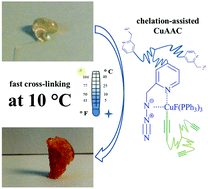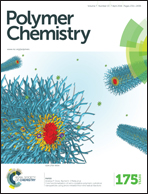Chelation-assisted CuAAC in star-shaped polymers enables fast self-healing at low temperatures†
Abstract
The achievement of self-healing (SH) under ambient conditions (low temperature, no external input of energy) still presents a significant area of research, and is strongly linked to fast and efficient cross-linking reactions. We investigate here fast cross-linking reactions of star-shaped polymers containing copper chelating moieties (picolinazide) at the end of each arm, able to promote a “click”-reaction through chelation of the Cu(I)-catalyst and thus strongly increasing cross-linking rates. The synthetic preparation and cross-linking kinetics of a low molecular weight model system (p-carboxylic-acid-methylester-picolinazide and phenylacetylene) were investigated by utilizing different catalysts (CuBr, CuBr(PPh3)3, Cu(MeCN)4PF6 and CuOAc) and applying in situ NMR experiments. The most efficient catalyst systems (CuBr, CuBr(PPh3)3, CuF(PPH3)3) were used to monitor the cross-linking of three-arm star polymers bearing the carboxylic acid-methylester-picolinazide moiety on each arm via melt-rheology studies, in turn enabling self-healing. The complete cross-linking of the components can be observed within 71 minutes even at low temperatures (10 °C), thus generating a highly efficient low-temperature SH-system. Self-healing of a polymeric material at room temperature was demonstrated, consisting of a star-shaped picolinazido-telechelic PIB, an encapsulated multivalent alkyne embedded within a high molecular-weight PIB matrix, together with CuBr(PPh3)3 and a fluorogenic dye, the latter acting as sensing tool for the proceeding click network formation. A damage-induced increase in the fluorescence intensity due to the click activation of the fluorogenic dye at room-temperature and the formation of a polymer network was thus proven. We envision that this highly enhanced cross-linking speed will facilitate applications of self-healing polymers under low temperature conditions.


 Please wait while we load your content...
Please wait while we load your content...